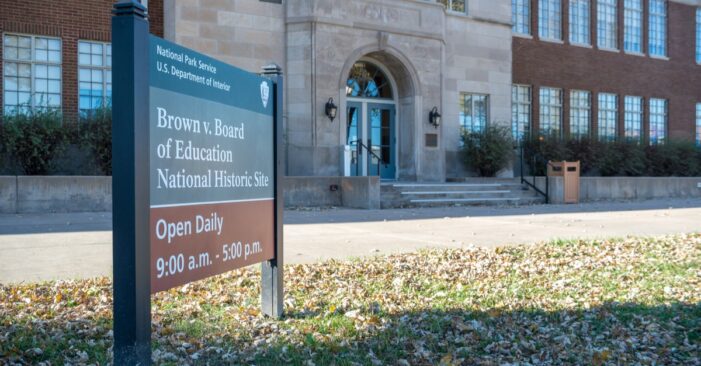Topeka, Kansas / United States of America – November 2nd 2019 : Brown v. Board of Education National Historic Site. Exterior of building, eastern facade with main entrance. (Shutterstock)
By Zachary Schermele
Nearly 19 million students in the U.S., or more than a third, attended a public school in the 2020-21 school year where at least 75% of students were of the same race or ethnicity, according to a report released Thursday by the Government Accountability Office.
The 45-page analysis looked at years’ worth of data from the Department of Education. It provides a stark assessment of the state of racial and socioeconomic equity for K-12 students.
Although the diversity of the total student population has increased in recent years, inequity persists, the report says.
“Ensuring equal access to educational opportunity — a key component of the Department of Education’s mission — remains a persistent challenge,” Jackie Nowicki, lead author and the director of K-12 education at the GAO, said in the report.
The new data also shows that 14% of students — about 7 million — attended schools where at least 90% of their peers were all of one race or ethnicity. Of the students attending schools where at least three-fourths of their peers were of their own racial or ethnic background, nearly half were white — compared to 31% Hispanic, 23% Black, 19% American Indian/Alaska Native, and 4% Asian students.
The number of students attending a mostly same-race or same-ethnicity school in 2020-21 (38%) was roughly the same, although slightly lower, as the number from the 2014-15 school year (42%). Over that same period of time, however, diversity among students has increased.
Over the past decade, when school districts have “seceded” from existing districts, those new districts were generally wealthier, with some exceptions, the watchdog agency also found. Secession slashed the percentage of students on free and reduced lunch in half on average. It also typically created higher concentrations of white students in new, smaller districts.
The report was delivered to U.S. Rep. Bobby Scott, a Virginia Democrat and chairman of the House Education and Labor Committee, on June 16. In a press release, Scott said that although the results of the report “will likely not be surprising to most, every American should be alarmed.”
“We know that school segregation doesn’t just isolate low-income students and students of color; it also deprives them of equal access to educational opportunities and resources,” Scott said.
GAO has provided the report to the Department of Education and Department of Justice for review.
“We simply cannot allow our progress toward educational equality in America to be further eroded,” Scott said in the release.

